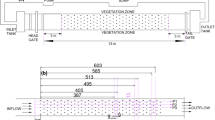Abstract
The effects of estuarine circulation and tidal trapping on transport in the Hudson estuary were investigated by a large-scale, high-resolution numerical model simulation of a tracer release. The modeled and measured longitudinal profiles of surface tracer concentrations (plumes) differ from the ideal Gaussian shape in two ways: on a large scale the plume is asymmetric with the downstream end stretching out farther, and small-scale (1–2 km) peaks are present at the upstream and downstream ends of the plume. A number of diagnostic model simulations (e.g., remove freshwater flow) were performed to understand the processes responsible for these features. These simulations show that the large-scale asymmetry is related to salinity. The salt causes an estuarine circulation that decreases vertical mixing (vertical density gradient), increases longitudinal dispersion (increased vertical and lateral gradients in longitudinal velocities), and increases net downstream velocities in the surface layer. Since salinity intrusion is confined to the downstream end of the tracer plume, only that part of the plume is effected by those processes, which leads to the largescale asymmetry. The small-scale peaks are due to tidal trapping. Small embayments along the estuary trap water and tracer as the plume passes by in the main channel. When the plume in the main channel has passed, the tracer is released back to the main channel, causing a secondary peak in the longitudinal profile.
Similar content being viewed by others
Literature Cited
Abood, K. 1974. Circulation in the Hudson estuary.Annals of the New York Academy of Sciences 250:39–111.
Blumberg, A. F., D. J. Dunning, H. Li, W. R. Geyer, andD. Heimbuch. 2004. use of a particle-tracking model for predicting entrainment at power plants on the Hudson River.Estuaries 27:515–526.
Blumberg, A. F., L. A. Khan, andJ. P. St. John. 1999. Three-dimensional hydrodynamic model of New York harbor region.Journal of Hydraulic Engineering 125:799–816.
Blumberg, A. F. andB. N. Kim. 2000. Flow balances in St. Andrews Bay revealed through hydrodynamic simulations.Estuaries 23:21–33.
Blumberg, A. F. andG. L. Mellor. 1987. A description of a three-dimensional coastal ocean circulation model, p. 1–16.In N. Heaps (ed.), Three-Dimensional Coastal Ocean Models. American Geophysical Union, Washington, D.C.
Ezer, T. andG. L. Mellor 2000. Sensitivity studies with the North Atlantic sigma coordinate Princeton Ocean Model.Dynamics of Atmospheres and Oceans 32:185–208.
Fischer, H. B. 1972. Mass transport mechanisms in partially stratified estuaries.Journal of Fluid Mechanics 53:671–687.
Geyer, R. W., J. H. Trowbridge, andM. M. Bowen. 2000. The dynamics of a partially stratified estuary.Journal of Physical Oceanography 30:2035–2048.
Ho, D. T., P. Schlosser, andT. Caplow. 2002. Determination of longitudinal dispersion coefficient and net advection in the tidal Hudson River with a large-scale, high resolution SF6 tracer release experiment.Environmental Science and Technology 36: 3234–3241.
Hunkins, K. 1981. Salt dispersion in the Hudson estuary.Journal of Physical Oceanography 11:729–738.
HydroQual. 2001. A Primer for ECOMSED. Report Number HQI-EH&S0101. HydroQual, Mahwah, New Jersey.
Kara, A. B., P. A. Rochford, andH. E. Hurlburt. 2002. Airsea flux estimates and the 1997–1998 ENSO event.Boundary-Layer Meteorology 103:439–458.
Okubo, A. 1973. Effect of shoreline irregularities on streamwise dispersion in estuaries and other embayments.Netherlands Journal of Sea Research 6:213–224.
Pritchard, D. W. 1954. A study of salt balance in a coastal plain estuary.Journal of Marine Research 13:133–144.
Pritchard, D. W. 1969. Dispersion and flushing of pollutants in estuaries.Journal of the Hydraulics Division 95:115–124.
Pritchard, D. W., A. Okubo, andE. Mehr. 1962. A study of the movement and diffusion of an introduced contaminant in New York Harbor waters. Technical Report 31. Chesapeake Bay Institute, Johns Hopkins, Baltimore, Maryland.
Smagorinsky, J. 1963. General circulation experiments with the primitive equations, I. The basic experiment.Monthly Weather Review 91:99–164.
Steward, Jr.,H. B. 1958. Upstream bottom currents in New York Harbor.Science 127:1113–1115.
Wanninkhof, R. 1992. Relationship between wind speed and gas exchange over the ocean.Journal of Geophysical Research 97: 7373–7382.
Author information
Authors and Affiliations
Corresponding author
Rights and permissions
About this article
Cite this article
Hellweger, F.L., Blumberg, A.F., Schlosser, P. et al. Transport in the Hudson estuary: A modeling study of estuarine circulation and tidal trapping. Estuaries 27, 527–538 (2004). https://doi.org/10.1007/BF02803544
Received:
Accepted:
Issue Date:
DOI: https://doi.org/10.1007/BF02803544




